| BitScope Blogs | BitScope Micro | Farnell element14 | Video Tutorial |
|
Bruce introduces BitScope Micro and demonstrates how it can be used with Raspberry Pi and some other systems to perform multi-channel mixed signal test and measurement. Starting with an unboxing he shows how to set up and use the software and connect with other lab equipment, how use the waveform generator to learn how an oscilloscope works, even what power line hum looks like simply putting his finger on a probe. Using a tiny mixed signal circuit he explained how BitScope Micro can enhance an understanding of electronic circuits and mixed signal systems and he explained how to program BitScope in Python and other languages. Bruce shows how to use BitScope Micro with Raspberry Pi and how it's no different to using it with a PC or Mac. He explains how you can use a Raspberry Pi to serve BitScope Micro over the Internet. Watch the VideoWe highly recommend you watch the video to see it in context including live demos of the software running on the Mac, Linux and Raspberry Pi as well as connection and usage examples. The video is information packed (about an hour) so we've broken it down and indexed it for you if you want to pick out something specific. If you're really short of time, there is also a series of slides that were used if you'd like to review the presentation quickly, just click the Farnell logo on each slide. Otherwise, sit back, relax with a good cup of coffee and enjoy the show ! Tutorial Video IndexTo view a single section, start the video and scroll to the time shown for the section you're interested in: 00:00 Welcome to the Webinar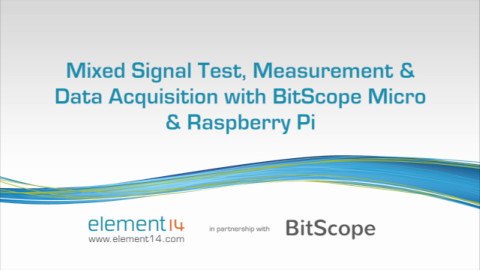 00:00 Welcome to the Webinar Christian Defeo from element14 hosted the webinar and handed over to Bruce Tulloch. Bruce introduced BitScope Designs and explained what we do and where we came from. He explained our focus on remotely accessible test & measurement and how Raspberry Pi fits in with this strategy starting with a compact BitScope model (BS10) and continuing with BitScope Micro. Bruce went on to explain why BitScope is well suited for educational purposes and how easy it is for new engineers, makers and others to use. He cited the positive response from students, teachers, makers and engineers as we promote its use in contexts where people use systems like Raspberry Pi. 04:30 Introducing BitScope Micro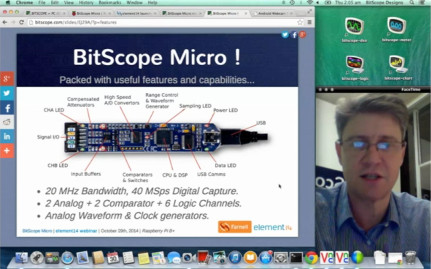 04:30 Introducing BitScope Micro Bruce then introduced the tiny new BitScope Micro which is main subject of this webinar. He explained that all BitScopes including Micro are digital and analog capture devices, usually configured as a mixed signal oscilloscope. In the case of BitScope Micro the product offers 2 analog and 8 logic channels where two of the logic channels connect via comparators from the analog channels. It includes a waveform generator and clock generator and can function as a logic, protocol and spectrum analyzer as well. Bruce explained how BitScope Micro works, based on its DSP core with an external high speed A/D and providing analog inputs electrically compatible with a standard oscilloscope. He also explained some unique features for a product in this price range such as analog offsets, range controls and waveform generation. 06:30 Unboxing BitScope Micro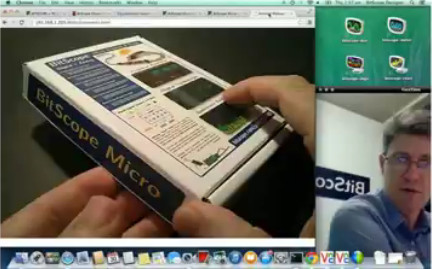 06:30 Unboxing BitScope Micro Bruce then proceeded to unbox a brand new element14 version of BitScope Micro. He showed the product itself and highlighted its simple but robust physical design where the PCB is enclosed in a tough heatsrink tube making it reasonably water resistant and tough enough to throw in your kit bag on the road. He unpacked the other accessories; the USB cable, a set of 10 mixed signal test clips and and quick start guide to get you up and running. Bruce explained how simple it is to get going, essentially just two steps; plug it into USB and start the software (which is downloaded from the BitScope Quick Start Page). He explained how the LEDs indicate that it's connected and working and then introduced the Raspberry Pi as the ideal companion to BitScope Micro, especially the Model B+ because it can provide enough power to run up to four BitScope Micros at once from a standard USB power supply. 09:30 Powering Up and Getting Started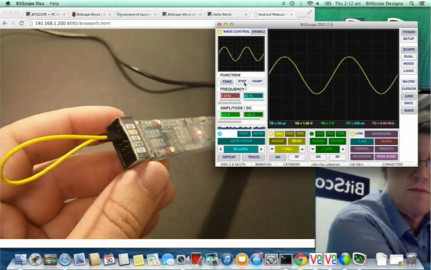 09:30 Powering Up and Getting Started Next, Bruce explained how to get started using BitScope Micro and how to tell it's working. BitScope Micro has everything you need to learn how to use it. The built-in waveform generator can produce waveforms which can be connected to the inputs using the supplied cables to see waveforms on the analog and logic channels. Bruce powered up BitScope DSO which is the recommended software for BitScope Micro on Raspberry Pi and proceded to demonstrate how to see a waveform using nothing but BitScope Micro itself. He connected the BitScope Micro waveform generator to analog channel A to demonstrate how easy it is to get a waveform up on the screen. Bruce then proceeded to demonstrate triggers, logic capture, mixed mode capture and the comparator channel CHA/D7. 16:00 BitScope Software Guided Tour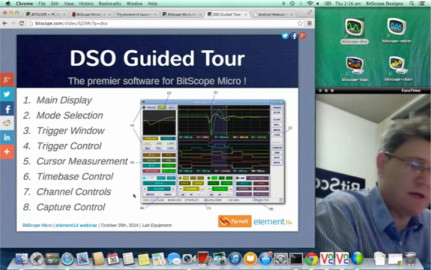 16:00 BitScope Software Guided Tour Bruce moved on to focus his attention to the BitScope DSO software itself. Using an instance of DSO running on a Linux PC he explained what the software can do and how to drive it effectively. He introduced the Act On Touch controls of the software allowing parameters to be changed by clicking, dragging and/or popping up a menu. Almost all parameters can be adjusted this way and Bruce demonstrated how it applies to input ranges, offsets, the timebase, trigger values, parameter tracking, probe attenuation and the delay timebase. He showed the built-in spectrum analyzer and explained how the cursors can be used to make measurements of voltages, times and offsets. 23:50 Connecting BitScope in the Lab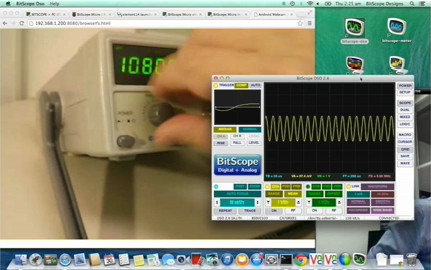 23:50 Connecting BitScope in the Lab A question that's oftern asked is how do you connect BitScope Micro to BNC terminated equipment? In this section Bruce showed one BNC adapter solution that's available and explains how BitScope Micro is designed to connect to all sorts of signals. Using a benchtop waveform generator he demonstrated how BitScope Micro works just like a standard oscilloscope. Here you can learn how BitScope's wide and variable input ranges and offsets, high resolution macro mode and sophisticated triggers can be used acquire and analyse arbitrary waveforms easily. Bruce demonstrated how you can see waveforms at very low levels with high fidelity using the macro mode and the high resolution A/D convertors built into BitScope Micro. 27:10 Using Oscillscope Probes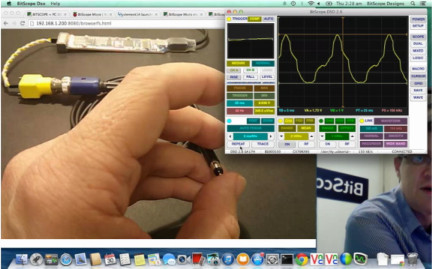 27:10 Using Oscilloscope Probes The BNC adapters for BitScope Micro allow the connection of standard oscilloscope probes too. Here Bruce explained that because BitScope Micro uses standard oscilloscope input impendances for its analog channels, all that's required to connect an oscilloscope probe is the BNC adapter making the whole range of probes designed for oscilloscopes available for use with BitScope Micro as well. He did a common test with an oscilloscope probe - put his finger on the probe tip to show the line voltage signal (50 Hz in Australia). This demonstrated that BitScope Micro is more than sensitive enough to be used in the same way. Bruce demonstrated how to measure the line frequency in both the time domain using time cursors and in the frequency domain using the built-in spectrum analyser. 29:35 Mixed Signal Circuit Analysis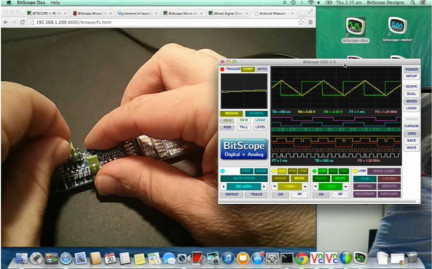 29:35 Mixed Signal Circuit Analysis Bruce introduced a small mixed signal circuit board based on Breadboad One which is designed to plug into BitScope Micro. Its purpose is to explain what mixed signal circuits are and how they work. It is the first in a range of educational circuits for BitScope Micro and here Bruce uses it to demonstrate how BitScope Micro lets you see in great detail how a mixed signal system works. Bruce showed the operation of a clock, binary counter, D/A converter, analog filter, schmitt trigger which configured as a mixed signal feedback loop produced an analog triangle waveform from a clock driven digital counter. Most importantly, all these elements of the circuit can been seen on the screen at once in real-time making it easy to see how each part of the circuit operates individually and how they work together as part of a complete mixed signal system. 34:05 Automated Testing & Diagnostics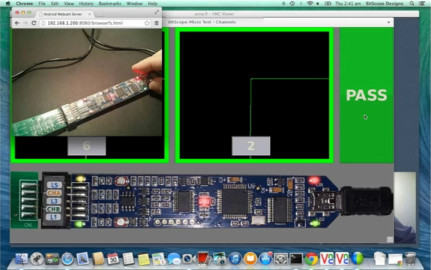 34:05 Automated Testing & Diagnostics One of the most powerful features of BitScope Micro is its diagnostic port combined with easy user programability. It allows BitScope Micro to be used in all sort of automated testing applications when connected to a circuit under test. It's ideal when used with Raspberry Pi (as the test computer). In this segment Bruce explains how we've used this capability to test BitScope Micro itself with an automated Quality Assurance (Q/A) program and a simple loopback circuit. This program and the test plug means BitScope Micro can be used to test itself in production - each new BitScope Micro comes straight off the production line, is powered up and tests itself using the test plug circuit in around 15 seconds. 38:00 BitScope Micro Python Applications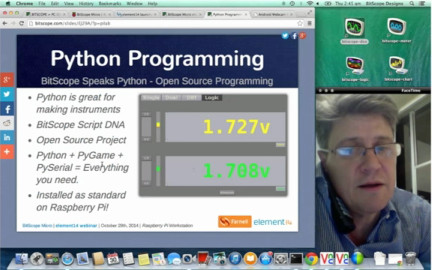 38:00 BitScope Micro Python Applications Automated testing is just the beginning as far as user programmablity is concerned. Bruce went on to explain some of the other open source python applications we've written for BitScope Micro. He showed examples for a single channel, dual channel and differential voltmeter, a simple oscilloscope and a logic analyzer, all written in pure Python as part of the soon to be released BitScope PiLab project. These applications are intended as starters for you to modify or use as inspiration for your own software for BitScope Micro. It means that if you have a specialised application for BitScope or the off-the-shelf software does not quite do what you want, with BitScope Micro you can roll your own solution. 39:20 How to Program BitScope Micro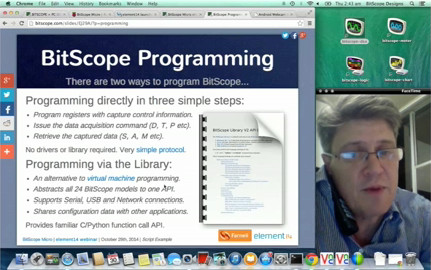 29:35 Mixed Signal Circuit Analysis So what's involved in rolling your own solution - writing your own software for BitScope Micro? In this section Bruce explained that there are two ways to program BitScope; via byte code strings or via a programming library with a C/Python API. He went on to explain the ASCII based script based byte code that is used to program all BitScopes (whether the library is used or not). He showed by way of example how to program the clock generator in BitScope Micro using a few simple strings sent to BitScope directly. He then went on to explain how Python and other scripting languages that handle strings well and use hash tables or dictionaries are ideally suited to programming BitScope directly. For example, the Raspberry Pi has everything needed (Python PyGame and PySerial) pre-installed to be able to programm and use BitScope Micro this way. 42:45 BitScope Micro on Raspberry Pi !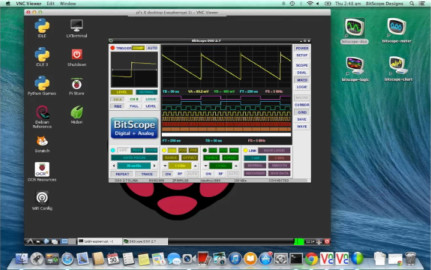 42:45 BitScope Micro on Raspberry Pi ! It turns out that Raspberry Pi is the perfect partner for BitScope Micro. Here Bruce explained how one Raspberry Pi B+ can power and run up to four BitScope Micros at once, either as a workstation running our standard BitScope DSO or as a server making the BitScope Micro available to remote clients. Bruce then powered up a Raspberry Pi and showed BitScope DSO (the same software that he previously showed running on a Mac and Linux machine) running on the Raspberry Pi itself. As with a lot of things on the Pi, start-up time can be a little slow but once it's running it works quite quickly and it works the same way as it does on any other supported computer. He then ran up BitScope Server, a tiny program that puts a BitScope Micro connected to a Raspberry Pi on the Internet and he ran BitScope DSO on the Mac connecting to the same BitScope that he previously showed running natively on the Raspberry Pi! 48:00 BitScope Micro Q & A and Accessories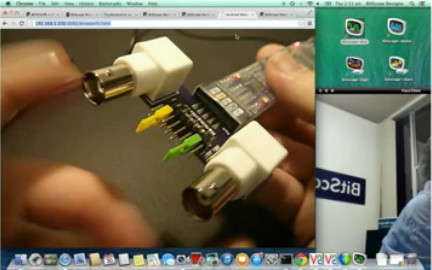 48:00 BitScope Micro Q & A and Accessories Bruce then took questions from the audience about Raspberry Pi bundles, technical specifications and accessories. Of particular interest was BitScope Micro "HammerHead", a soon to be released dual channel BNC adapter for BitScope Micro. Bruce explained that hammerhead also makes available the logic channels and can be configured to route the waveform and clock generators via the BNC ports as well. He took a range of other questions about software compatibility with other platforms and some software features and introduced a range of other accessories coming soon for Micro. These include ProtoSnap, a tiny prototyping system for BitScope Micro which can be used to create all sort of useful circuits and which can be powered by the BitScope Micro to which it is connected. 56:15 Thank-you for watching!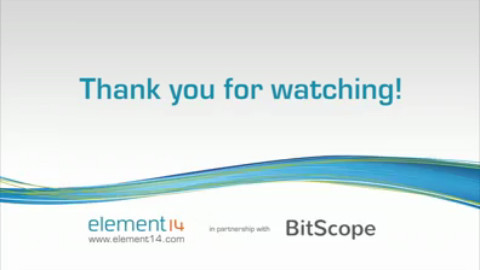 56:15 Thank-you for watching! Thank-you for watching! To learn more about BitScope Micro visit: To buy BitScope Micro please visit your nearest Farnell, element14 or Newark reseller or click the button below to be directed to your nearest reseller in the Farnell network. For more BitScope news please follow us: or bookmark our news page. Related Posts |
Copyright © 2023 BitScope Designs